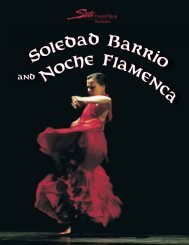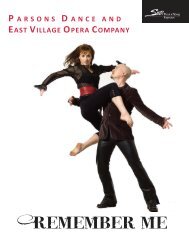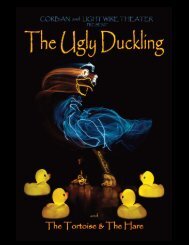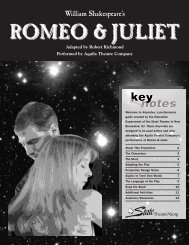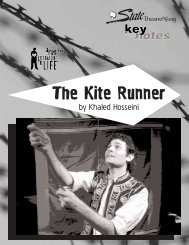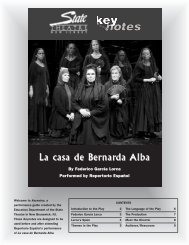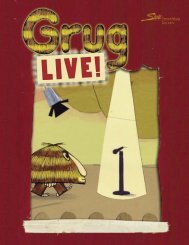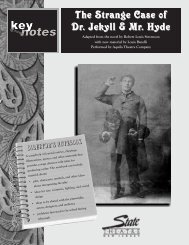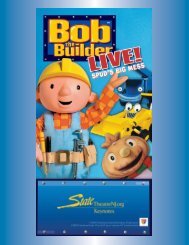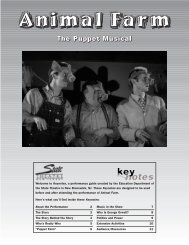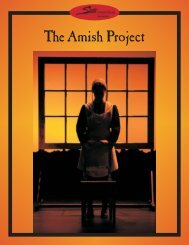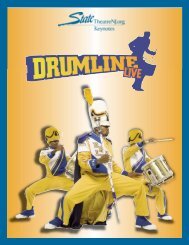The Nutcracker - State Theatre
The Nutcracker - State Theatre
The Nutcracker - State Theatre
Create successful ePaper yourself
Turn your PDF publications into a flip-book with our unique Google optimized e-Paper software.
American Repertory Ballet<br />
<strong>The</strong> <strong>Nutcracker</strong>
Welcome!<br />
2<br />
<strong>The</strong> <strong>State</strong> <strong>The</strong>atre in New Brunswick, New<br />
Jersey welcomes you to the school-day<br />
performance of <strong>The</strong> <strong>Nutcracker</strong>. We’re delighted<br />
to have you experience American Repertory<br />
Ballet’s fully-staged, full-length production of<br />
this popular story ballet.<br />
<strong>The</strong>se Keynotes provide information and<br />
activities to help you understand and enjoy the<br />
performance. Teachers can find additional<br />
resources for introducing ballet in the classroom<br />
at the Kennedy Center’s ArtsEdge website.<br />
CONTENTS<br />
Welcome/Acknowledgements 2<br />
About <strong>The</strong> <strong>Nutcracker</strong> 3<br />
<strong>The</strong> Story 4<br />
Delicious Dancing 5<br />
Meet the Composer 6<br />
Ballet Glossary 7<br />
Mime Time 8<br />
How Do <strong>The</strong>y Do That? 9<br />
Amazing Athletes 10<br />
Becoming a Ballerina 11<br />
<strong>The</strong> Production Team 12<br />
Get Ready! 13<br />
photo: Charles J. Devine<br />
Keynotes are made possible by a<br />
generous grant from Bank of<br />
America Charitable Foundation.<br />
<strong>The</strong> <strong>State</strong> <strong>The</strong>atre’s education program is funded in part by Bank of America Charitable Foundation,<br />
Colgate-Palmolive, <strong>The</strong> Geraldine R. Dodge Foundation, E & G Foundation, <strong>The</strong> Horizon Foundation for New<br />
Jersey, Johnson & Johnson Family of Companies, J. Seward Johnson, Sr. 1963 Charitable Trust, Karma<br />
Foundation, <strong>The</strong> Blanche and Irving Laurie Foundation, McCrane Foundation, MetLife Foundation, New<br />
Jersey <strong>State</strong> Council on the Arts, <strong>The</strong> Provident Bank Foundation, PSE&G, Robert Wood Johnson Foundation,<br />
and TD Bank. <strong>The</strong>ir support is gratefully acknowledged.<br />
Funding has been made possible in<br />
part by the New Jersey <strong>State</strong><br />
Council on the Arts/Department of<br />
<strong>State</strong>, a partner agency of the<br />
National Endowment for the Arts.<br />
United Airlines is<br />
the official airline<br />
of the <strong>State</strong><br />
<strong>The</strong>atre.<br />
<strong>The</strong> Heldrich is the<br />
official hotel of<br />
the <strong>State</strong> <strong>The</strong>atre.<br />
Keynotes are produced by the Education Department<br />
of the <strong>State</strong> <strong>The</strong>atre,<br />
New Brunswick, NJ.<br />
Mark W. Jones, President & CEO<br />
Lian Farrer, Vice President for Education<br />
Online at www.<strong>State</strong><strong>The</strong>atreNJ.org/Keynotes<br />
Keynotes for <strong>The</strong> <strong>Nutcracker</strong> written and designed by<br />
Lian Farrer. Edited by Kelly Blithe and David Sadowsky.<br />
© 2010 <strong>State</strong> <strong>The</strong>atre<br />
Find us at www.<strong>State</strong><strong>The</strong>atreNJ.org<br />
Contact: education@<strong>State</strong><strong>The</strong>atreNJ.org<br />
<strong>The</strong> <strong>State</strong> <strong>The</strong>atre, a premier nonprofit venue for the<br />
performing arts and entertainment.
About <strong>The</strong> <strong>Nutcracker</strong><br />
In 1816, the German writer E.T.A. Hoffmann published <strong>The</strong> <strong>Nutcracker</strong><br />
and the Mouse King, a frightening story involving a bloody battle between<br />
a nutcracker and a seven-headed mouse. He wrote it for adults, and did<br />
not intend it for children. In 1844 Alexandre Dumas (the author of <strong>The</strong><br />
Three Musketeers) ADAPTED Hoffmann’s story for<br />
younger audiences.<br />
ADAPT - to change<br />
something so it can<br />
It was Dumas’ version of the story that sparked<br />
be used for a specific<br />
the interest of Marius Petipa, the senior ballet<br />
purpose or for a<br />
master of the Russian Imperial Ballet. He hired the<br />
specific audience,<br />
Russian composer Pyotr Ilyich Tchaikovsky to<br />
such as turning a<br />
write a SCORE for the production. <strong>The</strong><br />
book into a movie.<br />
choreography was created by Petipa and Lev<br />
SCORE - the music<br />
Ivanov. <strong>The</strong> first performance of their new<br />
written for a ballet,<br />
<strong>Nutcracker</strong> ballet was on December 18, 1892 in St. play, film, opera, or<br />
Petersburg, Russia. <strong>The</strong> audience and critics did other performance<br />
not like it very much at first.<br />
<strong>The</strong> <strong>Nutcracker</strong> was not performed outside of Russia until 1934. It was<br />
first presented in the U.S. in 1944, by the San Francisco Opera Ballet, with<br />
new choreography by Willam Christensen. One of the most famous<br />
productions of the ballet was created by the New York City Ballet in 1954,<br />
choreographed by George Balanchine. Since then, <strong>The</strong> <strong>Nutcracker</strong> has<br />
become one of the best-loved performances of the Christmas season.<br />
Hundreds of ballet and theater companies all over the world perform it<br />
every year. This production is by American Repertory Ballet (ARB), who are<br />
celebrating their 47th year of performing <strong>The</strong> <strong>Nutcracker</strong>. <strong>The</strong> show<br />
features a cast of over 100 performers: ARB’s professional company of<br />
dancers as well as students from Princeton Ballet School.<br />
Adaptation<br />
Think of a book you really liked that was<br />
adapted into a movie (such as Harry<br />
Potter or Twilight). Make a list: in one<br />
column, list all the things in the movie<br />
that were the same. In the second<br />
column, list the things in the movie that<br />
were different from the book. Did you<br />
like or dislike any of the changes? Why<br />
do you think the changes were made?<br />
Why Do We Love <strong>The</strong><br />
<strong>Nutcracker</strong>?<br />
Though it is one of the most popular<br />
ballets today, <strong>The</strong> <strong>Nutcracker</strong> was not<br />
very successful when it was first<br />
performed in 1892. One critic wrote:<br />
For dancers there is little in it, for<br />
art absolutely nothing, and for<br />
the artistic fate of our ballet, one<br />
more step downward.<br />
<strong>The</strong> critic did not seem to think <strong>The</strong><br />
<strong>Nutcracker</strong> had much of a future,<br />
though history has proved him wrong!<br />
After you’ve seen the performance,<br />
discuss with your class: Why has this<br />
ballet been so successful for so long?<br />
3<br />
Clara and guests at the Christmas party
<strong>The</strong> Story<br />
Act I<br />
At the annual Christmas Eve party at the home of the Silverhaus family,<br />
Clara and Fritz anxiously await the lighting of the tree. To Clara’s horror<br />
and Fritz’s delight, the maid runs in, chasing a mouse through the hall.<br />
Father calls in the children, and the tree is lighted. <strong>The</strong> guests arrive: the<br />
Elegant Family, the Widow, her daughter and the Dapper Gent, and the Big<br />
Family with their nine children.<br />
After the children perform a festive dance, the mysterious Uncle<br />
Drosselmeyer and his Nephew arrive. To everyone’s delight, Drosselmeyer<br />
presents wonderful mechanical dolls: the Sugar Plum, the Cavalier, and the<br />
Soldier. He gives Clara, his favorite niece, a beautifully-carved <strong>Nutcracker</strong>.<br />
Fritz is jealous that Clara received such a marvelous gift. Grabbing the<br />
<strong>Nutcracker</strong> away from Clara, he drops it and breaks it. Drosselmeyer<br />
bandages the <strong>Nutcracker</strong> and gives it back to Clara. <strong>The</strong> party winds down:<br />
the guests depart, and the Silverhaus family goes to bed.<br />
Unable to sleep, Clara sneaks downstairs to the parlor. She picks up her<br />
<strong>Nutcracker</strong> and begins to dance with it. Strange shadows and the scurrying<br />
of little mice come to disturb her fun. Drosselmeyer reappears. To Clara’s<br />
amazement, he magically transforms the parlor into a battleground. Now<br />
grown life sized, <strong>Nutcracker</strong> and his Toy Soldiers defend the Christmas tree<br />
from the army of Rats and Mice. When her beloved <strong>Nutcracker</strong> is<br />
wounded, Clara defends him by throwing her shoe at the Rat King,<br />
vanquishing him and his awful troops.<br />
Drosselmeyer transforms the <strong>Nutcracker</strong> into the <strong>Nutcracker</strong> Prince.<br />
Angels appear as the parlor becomes the enchanted Land of Snow. Clara<br />
and the <strong>Nutcracker</strong> Prince meet the beautiful Snow Queen and King and<br />
are dazzled by the whirling of dancing Snowflakes.<br />
—Intermission—<br />
Act II<br />
In the Land of Sweets, Clara and the <strong>Nutcracker</strong> Prince are greeted by<br />
the Sugar Plum Fairy. <strong>The</strong> Prince tells the story of the great battle for the<br />
Christmas tree and how Clara saved the day. To reward Clara for her heroic<br />
deeds, the Sugar Plum Fairy presents dances from all the different Lands of<br />
the Sweets: Chocolate from Spain, Coffee from Arabia, Tea from China,<br />
Candy Canes from Russia, Marzipan from Germany, and Mother Ginger<br />
and her many children. A bouquet of Flowers performs a beautiful waltz,<br />
then the Sugar Plum Fairy dances with her Cavalier. After the grand finale,<br />
a very happy but tired Clara returns home to the comfort of the family<br />
parlor and dreams of her wonderful journey.<br />
Drosselmeyer and Clara<br />
Questions for Discussion<br />
What occasions do you celebrate with<br />
parties? Who attends? What do you do at<br />
these parties?<br />
Do you ever dance at parties? What kind of<br />
dancing do you do?<br />
Do you ever have disagreements with your<br />
brothers and sisters or other family<br />
members? What do you argue about? How<br />
do you resolve these conflicts?<br />
What special gifts have you received and<br />
what made them special?<br />
Have you ever been away on a trip? Where<br />
did you go?<br />
Where would you go if you could choose any<br />
fantasy or real place to visit?<br />
4<br />
If you went to a “Land of Sweets,” what<br />
foods would you like to find there?
Delicious Dancing<br />
5<br />
<strong>The</strong> second act of <strong>The</strong> <strong>Nutcracker</strong> begins in the Land of Sweets. Clara and the<br />
<strong>Nutcracker</strong> Prince find many beautiful flower buds. <strong>The</strong> Dew Drop Fairy opens<br />
the pods to reveal sweets from many lands. <strong>The</strong>y are followed by more dances<br />
to entertain Clara and the Prince. Here are all the dances in the Land of Sweets:<br />
Chocolate from Spain<br />
Coffee from Arabia<br />
Tea from China<br />
Candy Canes from Russia<br />
CHOREOGRAPHY - the<br />
steps, body movements, and<br />
patterns used in a dance<br />
Marzipan from Germany - Marzipan is a candy made from sugar and<br />
ground almonds.<br />
Mother Ginger - Mother Ginger’s 12 children delightfully frolic about.<br />
Waltz of the Flowers - A bouquet of flowers and the Dew Drop Fairy<br />
dance for Clara and the Prince.<br />
Grand Pas de Deux - <strong>The</strong> Sugar Plum Fairy and Cavalier dance a beautiful<br />
classical grand pas de deux (grand dance for two people).<br />
Dances of Many Lands<br />
While you are watching the different<br />
dances in the Land of Sweets, pay<br />
attention to the costumes, the music, and<br />
the CHOREOGRAPHY. How are the<br />
dances the same? How are they different?<br />
On a map, find the countries represented<br />
by the dances in the Land of Sweets.<br />
What do you know about each one?<br />
Create a travel poster for the Land of<br />
Sweets.<br />
What kinds of dances have been passed<br />
down in your family? What countries do<br />
they come from? What do these dances<br />
look like? When do you dance them? Are<br />
there special shoes or costumes? What<br />
kind of music is played?<br />
Finale - <strong>The</strong> big Finale is danced by all of the Sweets.<br />
Visions of Sugar Plums<br />
<strong>The</strong> Sugar Plum Fairy gets her name from a<br />
traditional Christmas treat from England. <strong>The</strong>y<br />
were originally plums covered in sugar. <strong>The</strong>y later<br />
became small, plum-shaped candies made from<br />
dried fruit, nuts, honey, and spices coated in sugar.<br />
Here’s a recipe for making your own sugar plums.<br />
2 cups whole almonds<br />
1 cup mixed dried fruit, such as<br />
prunes, apricots, dates, or figs<br />
2 teaspoons grated orange zest<br />
1 1/2 teaspoons ground cinnamon<br />
1/2 teaspoon ground allspice<br />
1/2 teaspoon nutmeg<br />
1/4 cup honey<br />
1 cup powdered sugar<br />
Preheat the oven to 400º. Place the almonds in a single layer on a baking sheet and toast<br />
them in the oven for 10 minutes. In a food processor, chop the almonds and dried fruit. In<br />
a bowl, mix together the orange zest, spices, and honey. Add the chopped nuts and fruit<br />
and mix well.<br />
Pinch off rounded teaspoon-sized pieces of the mixture and roll them into balls. Roll the<br />
balls in the powdered sugar and refrigerate them in single layers between sheets of<br />
waxed paper in airtight containers.<br />
photo: George Jones<br />
Makes about 36 sugar plums.<br />
Spanish Dancers
Meet the Composer<br />
6<br />
“Truly there would be<br />
a reason to go mad<br />
were it not for<br />
music.”<br />
—Tchaikovsky<br />
A Sweet Suite<br />
Many people confuse <strong>The</strong> <strong>Nutcracker</strong><br />
ballet with <strong>The</strong> <strong>Nutcracker</strong> Suite. A suite<br />
(pronounced ‘sweet’) is made up of<br />
portions of music from a ballet, opera,<br />
play, or film, rearranged for an orchestra<br />
to play. In <strong>The</strong> <strong>Nutcracker</strong> Suite,<br />
Tchaikovsky put together sections of<br />
music from the ballet into a piece of<br />
music to be performed in concert—without<br />
the dancers. And so, you watch <strong>The</strong><br />
<strong>Nutcracker</strong> ballet, but you listen to <strong>The</strong><br />
<strong>Nutcracker</strong> Suite!<br />
Heavenly Music<br />
Pyotr Ilyich Tchaikovsky ( 1840-1893) was a Russian composer,<br />
conductor, and music professor. Born in Votkinsk, Russia, into a wealthy<br />
family, he began composing music at age 14. As his family wished, he went<br />
to law school, but gave up this career to study music at the St. Petersburg<br />
Conservatory. In 1866, he moved to Moscow, where he was introduced to<br />
many of Russia’s most influential composers.<br />
Tchaikovsky went on to write operas, symphonies, piano and violin<br />
concertos, and other pieces. He is considered by many to be the greatest<br />
composer of music for ballet; in addition to <strong>The</strong> <strong>Nutcracker</strong>, he wrote the<br />
music for the ballets Swan Lake and <strong>The</strong> Sleeping Beauty. Outside of ballet,<br />
his best-known works are the 1812 Overture, Romeo and Juliet Fantasy<br />
Overture, Violin Concerto, Piano Concerto No. 1, Symphony No. 6 (the<br />
“Pathétique” Symphony), and the operas Eugene Onegin and <strong>The</strong> Queen of<br />
Spades. Tchaikovsky’s music is in the Romantic style, filled with strong<br />
emotions and lush melodies. He is notable for incorporating traditional<br />
Russian music (including folk melodies) into Western classical music.<br />
During his lifetime, Tchaikovsky become enormously popular<br />
throughout Europe and abroad. On a concert tour of America in 1891, he<br />
conducted some of his music at the very first performance at New York’s<br />
Carnegie Hall. Despite his success, the composer suffered from anxiety and<br />
depression, suffering several nervous breakdowns. Some scholars believe<br />
that his death—he died of cholera after drinking contaminated water—was<br />
a suicide, though this is impossible to prove.<br />
During the Dance of the Sugar Plum Fairy,<br />
listen closely for a musical instrument<br />
called the celesta. <strong>The</strong> word ‘celesta’<br />
comes from a<br />
French word that<br />
means<br />
‘heavenly.’ <strong>The</strong><br />
instrument<br />
looks like a piano<br />
and sounds like<br />
fairy bells or a<br />
music box.<br />
<strong>The</strong> Romantic Era<br />
Tchaikovsky was one of the great<br />
composers of the Romantic Era.<br />
Romanticism was a movement in art,<br />
music, literature, dance, and theater. <strong>The</strong><br />
focus was on expressing intense<br />
emotion—and not just about love.<br />
Recurring themes included imagination,<br />
love, nature, and the supernatural.<br />
Besides Tchaikovsky, prominent Romantics<br />
included composers Frédéric Chopin and<br />
Richard Wagner; writers Samuel Taylor<br />
Coleridge, Herman Melville, and Edgar<br />
Allan Poe; and painters J.M.W. Turner and<br />
Francisco Goya.
Ballet Glossary<br />
Ballet began in France more than 300 years ago. For this reason, most of the<br />
vocabulary used in ballet today is French. Here are some common ballet terms:<br />
7<br />
ARABESQUE (are-ah-BESK) - a position where the dancer stands on one leg<br />
with the other leg stretched straight out behind, parallel to the floor<br />
ATTITUDE (ah-tee-TUDE) - a position where the dancer stands on one leg<br />
with the other leg curved to the back<br />
BARRE (BAR) - a horizontal wooden bar fastened to the walls of the ballet<br />
studio. <strong>The</strong> dancer holds onto it for support while practicing. Every ballet class<br />
begins with exercises at the barre.<br />
ARABESQUE<br />
photo: Gene Schiavone<br />
CHAÎNÉS (sheh-NAY) - a series of quick turns done moving forward in a<br />
straight line or circle<br />
Pictured: Daniil Simkin<br />
CHASSÉ (shah-SAY) - a series of steps where one foot “chases” the other<br />
across the floor<br />
CORPS DE BALLET (CORE duh ba-LAY) - the dancers in a ballet who do not<br />
perform a solo part<br />
DÉVELOPPÉ (day-vlaw-PAY) - a move in which one leg is raised with the knee<br />
bent, then slowly extended into an open position<br />
EN POINTE (ahn PWAHNT) - dancing on the tips of the toes. Dancing en<br />
pointe gives the impression of floating on the air. In ballet, only women dance<br />
en pointe.<br />
FOUETTÉ (fweh-TAY) - a quick “whipping” movement of the raised leg, usually<br />
as part of a pirouette<br />
GRAND JETÉ (GRON zhuh-TAY) - a broad, high leap with one leg stretched<br />
forward and the other back like a “split” in the air<br />
ATTITUDE<br />
PLIÉ WITH<br />
TURNOUT<br />
PAS DE DEUX (PAH de DUH) - a dance for two people, usually a male and<br />
female. <strong>The</strong> pas de deux sections of a ballet usually express intense emotion,<br />
such as love, sadness, or joy.<br />
PORT DE BRAS (por duh brah) - the way the arms are held and moved<br />
PIROUETTE (peer-oo-WET) - a whirl or spin done on one foot<br />
PLIÉ (plee-AY) - lowering the body by bending the knees<br />
TOUR JETÉ (TOOR zhuh-TAY) - a jump from one foot to the other while<br />
making a haf turn<br />
TURNOUT - a basic ballet position where the feet and legs turn outward from<br />
the hips in a 90-degree angle<br />
VARIATION - a solo dance<br />
Pictured: Steven McRae<br />
GRAND JETÉ<br />
photo: © Bill Cooper
Mime Time<br />
8<br />
In this scene from the ballet Sleeping<br />
Beauty, the Lilac Fairy uses pantomime<br />
gestures to show that she is preventing<br />
the evil Carabosse from harming<br />
Princess Aurora.<br />
Pantomime Activities<br />
Pacific Northwest Ballet. Photo © Angela Sterling<br />
<strong>The</strong> <strong>Nutcracker</strong> is a STORY BALLET. It tells a story using movement and<br />
dance, but the dancers do not speak. During a ballet, you will sometimes<br />
see the dancers stop their leaps and twirls to act out parts of the story<br />
with gestures and facial expressions. This is called MIME. Mime helps the<br />
audience understand what is happening and what characters are thinking<br />
and feeling. If you’ve ever played charades, then you have done mime.<br />
Here are some common mime gestures used in story ballets, along<br />
with their meanings.<br />
• ANGER: Shake fist strongly<br />
• ASK: Clasp hands together in pleading gesture<br />
• BEAUTIFUL: Hand circles face<br />
• DANCING: Roll hands from front of body to overhead<br />
• DEATH: Arms straight in front, crossed at wrists with hands in fists<br />
• I/ME/MINE: Hand points to chest to indicate oneself<br />
• LOVE: Hands over heart<br />
How does pantomime differ from dance? How<br />
can you use gestures, facial expressions, and<br />
mannerisms to create different characters?<br />
Explore ways of communicating without<br />
talking. Can you say ‘yes’ without speaking?<br />
Can you say ‘no’, ‘I don’t know’, or<br />
‘hello/goodbye’?<br />
Try saying ‘yes’ using different body parts. Try<br />
it again, this time changing the tempo<br />
(speed) of your movements. <strong>The</strong>n experiment<br />
with the energy of your movements: tense,<br />
relaxed, heavy, light, smooth, choppy, etc.<br />
Without speaking, perform one of the<br />
gestures from the mime vocabulary for the<br />
rest of your class and see if they can guess<br />
the meaning. <strong>The</strong>n create a brief “sentence”<br />
using pantomime and perform it for your<br />
class.<br />
Listen to selections of Tchaikovsky’s music for<br />
<strong>The</strong> <strong>Nutcracker</strong>. Create a pantomime that<br />
expresses how the music makes you feel.<br />
• MARRIAGE: Index finger points to ring finger of left hand<br />
• MONEY: Rub thumb and fingers of one hand together<br />
• NO/NEVER: Palms down, hands wave over each other, crossing at<br />
wrist<br />
• OBEY: Point strongly to floor with index finger<br />
• THINK: Touch or point to temple<br />
<strong>The</strong> New York City Ballet has a video<br />
demonstrating some mime vocabulary.<br />
www.nycballet.com/nycb/flash/mime_final.htm<br />
• SAD: Fingers trace tears down cheek or wipe away tears
How Do <strong>The</strong>y Do That?<br />
9<br />
Ballet is a highly technical type of dance that takes years of study and<br />
practice to perform well. Dancers learn special techniques for executing the<br />
movements beautifully and with perfect precision—and for making it all look<br />
effortless! Besides training their bodies, ballet dancers have to learn a<br />
complicated movement vocabulary: the different body positions, movements,<br />
and patterns. One of the first things dancers are taught are the five basic foot<br />
and arm positions that are the building blocks of ballet.<br />
FIRST POSITION<br />
SECOND POSITION<br />
THIRD POSITION<br />
FOURTH POSITION<br />
FIFTH POSITION<br />
Staying<br />
on <strong>The</strong>ir Toes!<br />
In the performance, you’ll see many of the female dancers performing en pointe—<br />
on the tips of their toes. In this technique, the dancers appear to be floating. It takes<br />
years of special training for a dancer to be able to do all those steps and turns while<br />
balanced on the ends of her toes. It also takes special shoes—pointe shoes—that<br />
are designed to help the ballerina dance en pointe. Here’s how they work:<br />
RIBBONS - Hold the shoe on the foot. <strong>The</strong>y are made of cloth and tied with a<br />
special flat knot. <strong>The</strong> ribbons are crossed over the ankle to help give support—just<br />
the way athletes “strap up” their ankles with tape.<br />
SHANK - <strong>The</strong> “backbone” of the shoe. This stiff inner sole is made of heavy leather.<br />
<strong>The</strong> shank helps transfer the dancer’s weight from the toes into the arch, which is<br />
the strongest part of the foot.<br />
BOX — Made of layers of cloth hardened with glue. This stiff inner shell protects the<br />
dancer’s toes, softening the impact of steps and jumps. Even with this protection, a<br />
dancer’s toes can sometimes start to bleed from dancing en pointe.
Amazing Athletes<br />
10<br />
Dancers are not just performers—they are elite<br />
athletes. <strong>The</strong>y have amazing flexibility, muscular strength<br />
and both physical and mental endurance. <strong>The</strong>y are able to<br />
leap, land, and turn with grace. To stay in top condition,<br />
they follow a rigorous training routine. Professional<br />
dancers practice an average of six hours per day.<br />
Believe it or not, quite a few football players take ballet<br />
classes! Since the 1970s, they’ve used ballet and other<br />
types of dance to improve their agility, balance, and<br />
control.<br />
Believe It or Not...<br />
• <strong>The</strong> average NBA player can jump 2½ feet in the air. Ballet<br />
dancer Mikhail Baryshnikov was said to have jumped 5-6 feet<br />
in the air.<br />
• A 1975 study in the Journal of Sports Medicine listed the three<br />
most physically and mentally taxing sports. Ballet was #1,<br />
football was #3. In between? Bullfighting.<br />
Pictured: Zhong-Jing Fang<br />
Men in Ballet<br />
When a lot of people think of ballet, they<br />
think of women in frilly tutus, dancing gracefully<br />
on the tips of their toes. But ballet dancing is not<br />
just for women and girls. As a matter of fact,<br />
when ballet was first invented, women were not<br />
even allowed to appear on stage!<br />
Ballet was born in the 15th century in the<br />
royal courts of Italy and France. At first, all the<br />
dancers were male—female roles were danced<br />
by men wearing masks. By the 1680s, dancers of<br />
both sexes were equally admired. By the 19th<br />
century, however, women dancers dominated the<br />
ballet stage. It was not until the 1960s, when<br />
Russian male dancers such as Vaslav Nijinsky,<br />
Rudolf Nureyev, and Mikhail Baryshnikov showed<br />
that men could be ballet superstars, too!<br />
Pictured: Carlos Acosta
Becoming a Ballerina<br />
11<br />
Alexandra and Amanda Torres are two of the over 100 performers in<br />
American Repertory Ballet’s <strong>The</strong> <strong>Nutcracker</strong>. In the show, they both play<br />
Soldiers. Alexandra, who is 13, and Amanda, who is 12, began their dance<br />
training in the company’s DANCE POWER program, which introduces the<br />
basic concepts of dance to every third grader in the New Brunswick<br />
schools. <strong>The</strong>y also got to see <strong>The</strong> <strong>Nutcracker</strong> at the <strong>State</strong> <strong>The</strong>atre. Dance<br />
Power was their very first experience with ballet.<br />
After third grade, both Alexandra and Amanda received scholarships to<br />
continue studying dance at the American Repertory Ballet’s studio in New<br />
Brunswick. As they became more and more skilled, they were eventually<br />
chosen to perform with the company in <strong>The</strong> <strong>Nutcracker</strong>. <strong>The</strong> sisters<br />
discuss what it’s like to be a dancer.<br />
Q: How often/how many hours do you practice and take<br />
class each week?<br />
A: Both of us take 3 hours of class each week. We<br />
also try to practice 20 minutes a day. During<br />
rehearsals for <strong>The</strong> <strong>Nutcracker</strong>, we have to<br />
rehearse every Saturday and Sunday.<br />
Alexandra and<br />
Amanda Torres<br />
Q: What’s your part in the <strong>Nutcracker</strong>?<br />
A: Last year we were Candy Cooks. Alexandra - This<br />
year I would love to be a Snow Ball or a Solider.<br />
Amanda - I would like to play those roles too. I would<br />
also love to be a party guest or a Russian.<br />
Q: Do you get nervous performing in front of the audience?<br />
A: We do! We try to ignore it, though. When we’re on stage<br />
we try not to look at the audience. If we make a mistake<br />
we act like it’s part of the role.<br />
Q: Do you like attending dance performances?<br />
A: We love watching ballet. Last year we saw Sleeping Beauty<br />
and Swan Lake.<br />
Q: What advice would you give a young person who is<br />
considering getting into dance?<br />
A: Dance is fun and you get many friends from class. It’s<br />
easier then we first thought it would be. When we<br />
saw <strong>The</strong> <strong>Nutcracker</strong> before taking class, we didn’t<br />
know how we would ever be able to be in the show,<br />
but now we are!
<strong>The</strong> Production Team<br />
12<br />
A movie is exactly the same every time you see it. But no two live<br />
performances are ever the same. You could see <strong>The</strong> <strong>Nutcracker</strong> a hundred<br />
times, and each time it would be different. <strong>The</strong> differences may be small, or<br />
they may be huge.<br />
Every ballet company that decides to present <strong>The</strong> <strong>Nutcracker</strong> starts with the<br />
same music and the same story. <strong>The</strong>n they bring together their own creative<br />
team to invent the choreography, costumes, lighting, and sets and to select<br />
the dancers who will perform the roles. <strong>The</strong>y might decide to create a<br />
traditional <strong>Nutcracker</strong>, or they may choose to go in an entirely different<br />
direction: changing the time period, location, etc. Can you imagine a<br />
<strong>Nutcracker</strong> that is set on Mars? How about in a shopping mall?<br />
Each member of the production team contributes special talents,<br />
training, and ideas. Some of the people on <strong>The</strong> <strong>Nutcracker</strong> team include:<br />
CHOREOGRAPHER creates the dances.<br />
COSTUME DESIGNER researches, designs, and supervises the<br />
construction of the costumes.<br />
SET DESIGNER creates the designs for the scenery, including the<br />
backdrops, props, and furniture.<br />
LIGHTING DESIGNER uses the color, intensity (brightness), and placement of<br />
the lights to create a mood for each scene.<br />
STAGE MANAGER supervises the technical crew during the performance,<br />
giving cues for lighting and when to raise and lower the curtain. <strong>The</strong> stage<br />
manager also tells the performers when to make their entrances onstage.<br />
WARDROBE MASTER or WARDROBE MISTRESS takes care of the costumes,<br />
shoes, and wigs by cleaning and mending them as necessary.<br />
Putting It All Together<br />
After the performance, write a review.<br />
Talk about the different elements of<br />
the performance: not just the dancers,<br />
but the contributions of the entire<br />
production team: choreography,<br />
lighting, costumes, and sets. Here are<br />
some questions to help you think<br />
about what to include in your review.<br />
What were your feelings when you<br />
first learned that you were going to<br />
see a ballet? Do you still feel the same<br />
way after seeing the performance?<br />
Choreographer<br />
Mark Morris calls<br />
his version of <strong>The</strong><br />
<strong>Nutcracker</strong> “<strong>The</strong><br />
Hard Nut.”<br />
What were the three things that you<br />
liked most about the performance?<br />
What three things in the show would<br />
you like to change?<br />
Was there anything about the show<br />
that was different than you expected?<br />
Would you like to see another ballet?<br />
Photo: © Peter DeSilva
Get Ready!<br />
Step 1: Learn Your Part.<br />
At the theater, you join in a special partnership between the<br />
audience and the performers. As a member of the audience, you need<br />
to do your part to make the show a success. During the performance,<br />
your job is to focus all your energy and attention on what’s happening<br />
onstage.<br />
<strong>The</strong> way you respond to the show matters a great deal to the<br />
performers. Laugh at the funny parts. Applaud if you like what you see<br />
and hear!<br />
Here are some rules of behavior for a live performance:<br />
Turn it off!<br />
Before the performance starts, turn off<br />
and put away all electronic devices:<br />
cellphones, iPods, games, etc.<br />
And no texting during the show!<br />
Step 2: Find Out More.<br />
13<br />
BOOKS<br />
Appreciating Dance: A Guide to the World’s Liveliest<br />
Art, by Harriet Lihs. Princeton Book Company, 2009. A<br />
comprehensive guide to all forms of dance. Includes<br />
questions for discussion.<br />
Ballet School, by Naia Bray-Moffatt and David<br />
Handley. DK Children, 2003. Grades K-3<br />
<strong>The</strong> <strong>Nutcracker</strong>, by E. T. A. Hoffmann; Ralph Manheim<br />
(translator), Maurice Sendak (illustrator). Crown<br />
Publishing, 2001<br />
DVD<br />
George Balanchine’s <strong>The</strong> <strong>Nutcracker</strong>. New York City<br />
Ballet production featuring Darci Kistler and Damian<br />
Woetzel, narrated by Kevin Kline. Warner Home<br />
Video, 1997<br />
No Food!<br />
Do not eat, drink, or chew gum<br />
in the theater.<br />
No Photos!<br />
<strong>The</strong> audience is not allowed to<br />
take photos or make any video or<br />
sound recording of the show.<br />
<strong>The</strong> Hard Nut. A modern adaptation of <strong>The</strong> <strong>Nutcracker</strong><br />
by Mark Morris. Nonesuch, 2007<br />
<strong>The</strong> <strong>Nutcracker</strong>. American Ballet <strong>The</strong>atre production<br />
featuring Mikhail Baryshnikov and Gelsey Kirkland.<br />
Kultur Vide, 2004<br />
MUSIC<br />
<strong>The</strong> <strong>Nutcracker</strong> (complete ballet music), by Pyotr<br />
Illyich Tchaikovsky. Kirov Orchestra and Choir, Valery<br />
Gergiev, conductor. Polygram<br />
<strong>The</strong> Harlem <strong>Nutcracker</strong>, by David Berger, Duke<br />
Ellington, and Billy Strayhorn. Such Sweet Thunder,<br />
1999. A jazz rendering of themes from Tchaikovsky’s<br />
ballet score.<br />
WEBSITES<br />
Quiet, Please!<br />
No talking or whispering once the<br />
show begins. Remain quietly in your<br />
seat during the entire performance.<br />
American Ballet <strong>The</strong>atre’s Ballet Dictionary. Features<br />
video clips illustrating the dance terms<br />
www.abt.org/education/dictionary/index.html<br />
American Repertory Ballet<br />
www.arballet.org<br />
<strong>The</strong> <strong>Nutcracker</strong> website<br />
www.nutcrackerballet.net



